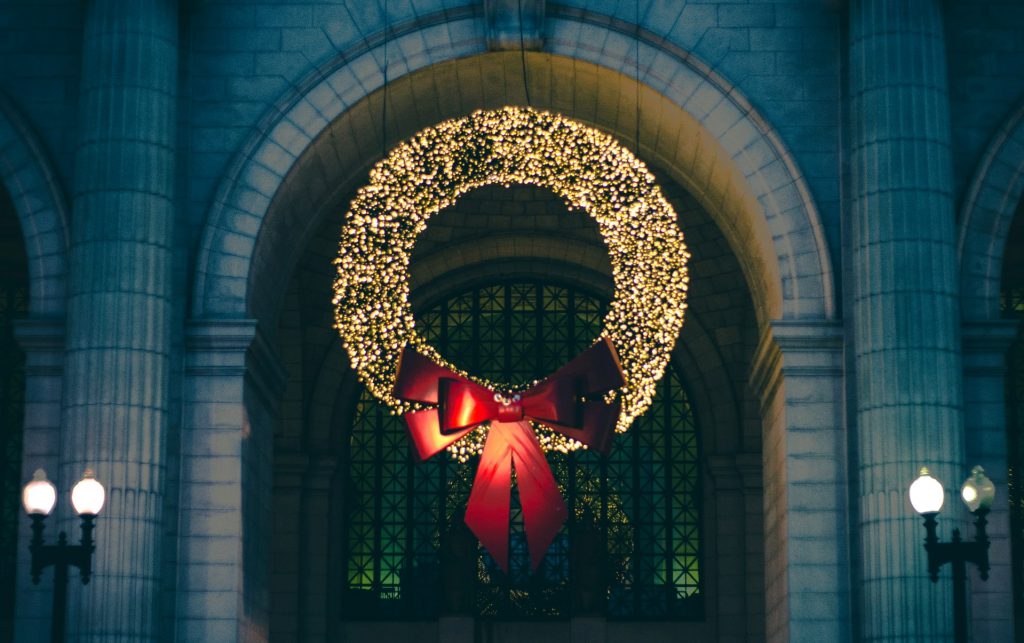
Greek or Roman?
It is possible that the Christmas Wreath has it origins not in a religious festival but a sporting one. A wreath was initially used to represent a person’s status or occupation in Greek and Roman times. But under the Greeks the laurel wreath became the crown of victors at the Pythian games approximately 582BC. The Romans carried on the tradition and used the wreath as a sign within Roman society for the arts, government, education and literature. Julius Caesar even claimed it to be ‘a symbol of the supreme ruler’. This symbol of greatness and rule would later be replaced by kings with jewels and gold to be come crowns. Some scholars believe that the wreath may not descend from the Greeks, but the Persians. Royalty in that ancient culture would wear a fabric headband or diadem which would have been covered in gems.
But perhaps, the wreath of the Christmas Advent is more related to the traditions of the ancient Egyptians, Chinese and Hebrew customs. Evergreen branches of the conifer trees symbolised eternal life through the long winter months. In Northern Europe, particularly in pagan Germany, there are folk tales of evergreen wreaths. Symbolising the coming of the Spring and the renewed light that Spring brings. It is also possible that the door wreath as opposed to the horizontal Advent Wreath was used in Europe as a way to give a family an identity, similar to that of a family crest. Therefore produce often grown by the family would hang on the door, like flowers and grapevines.
The Christian Advent Wreath symbolises the coming of Christ. It is usually a circle made of evergreen plants with four candles and is horizontal. The four candles represent the four Sundays before Christmas Day. Hence the first candle is lit on Advent Sunday. The fourth on the Sunday before Christmas.
Why a Christmas Wreath is Circular
The circular shape of the wreath is symbolic as it represents the ‘eternal cycle of the seasons’, the evergreen of the wreath and the lighting of the candles the persistence of life. As a Christian symbol it is unclear of its origins. Some scholars believe it could be from the Middles Ages, others a German custom from the 16th Century or possibly an invention in the 19th Century. The modern Advent wreath is credited to Johann Hinrich Wichern. In 1839 he built for the children of his mission school a large wooden ring (an old cartwheel) and placed on it 4 large white and 19 smaller red candles so to help the children count down the days til Christmas. On each Sunday of Advent one of the white candles was lit. In the 1920’s German Catholics had adopted the wreath and in the 1930’s it had gained popularity in the United States.
Christmas Wreath and the Catholic Church
The Catholic church traditionally uses two colours for the candles, purple and rose. The purple candles are associated with royalty, in this case that of Jesus being the Prince of Peace. Three of the candles are purple. Therefore there is only one rose coloured candle. This is used on the third Advent Sunday, known as Gaudete Sunday. Gaudete originates from the Latin for rejoice. In the Protestant faith it is traditionally four red candles. In Anglican and Lutheran faiths it is blue. Additionally some wreaths have an additional candle, usually white, which is known as Christ Candle and is lit on Christmas Eve or Christmas Day.
Other Wreath Traditions
Other traditions are that the four candles relate to different events surrounding the birth of Jesus. The first Advent candle symbolises the coming of Jesus, this is the Prophet’s candle. The second the Bethlehem candle to honour the place of Jesus’ birth. The third the shepherd’s candle and the fourth the Angels’ candle and the proclamation of joy for Jesus’ birth.
The materials that make up a wreath are also very symbolic. The evergreens are a symbol of the strength of life. Leaves, holly, pine and fruit are for immortality. Cedar for healing and strength.